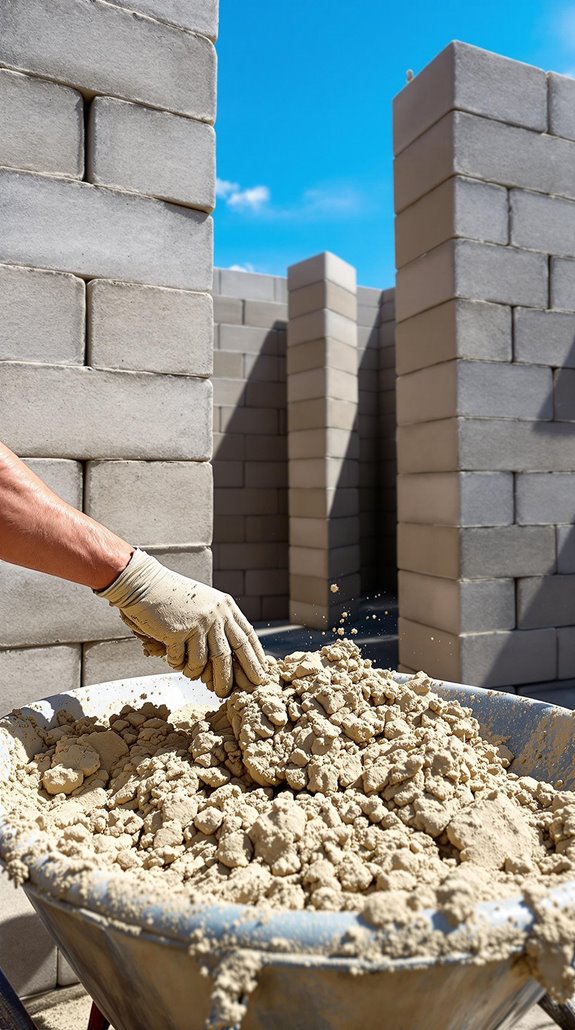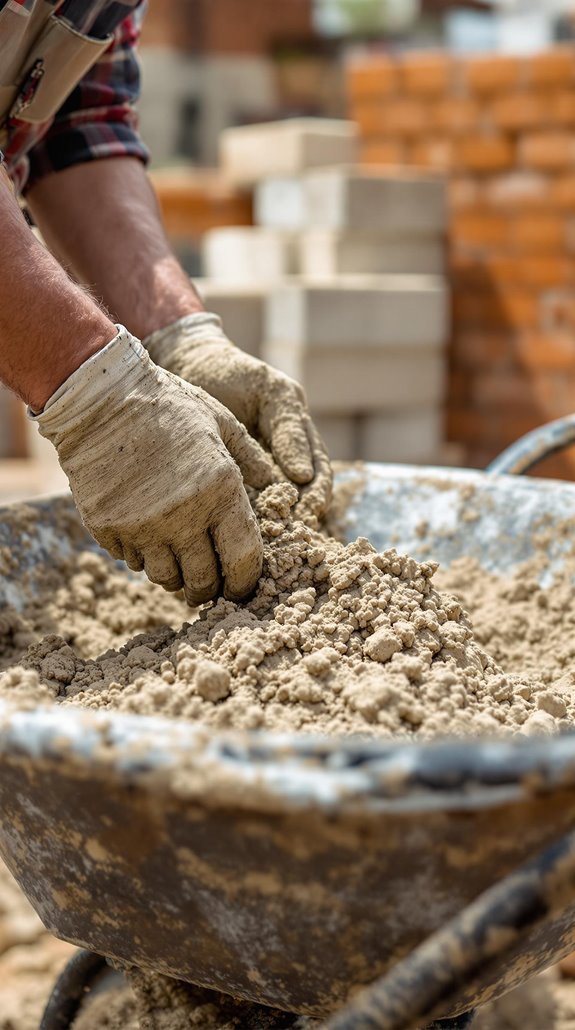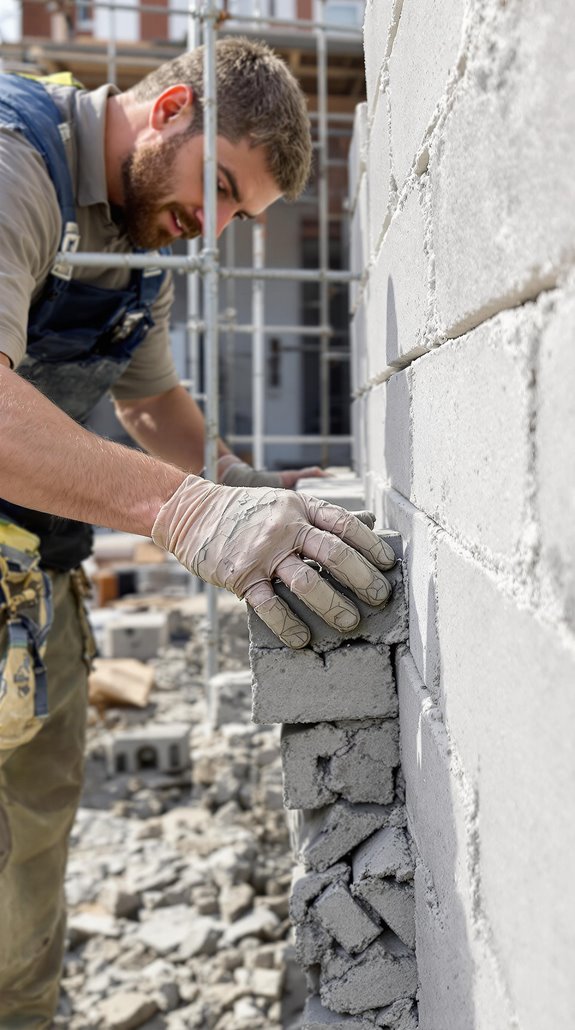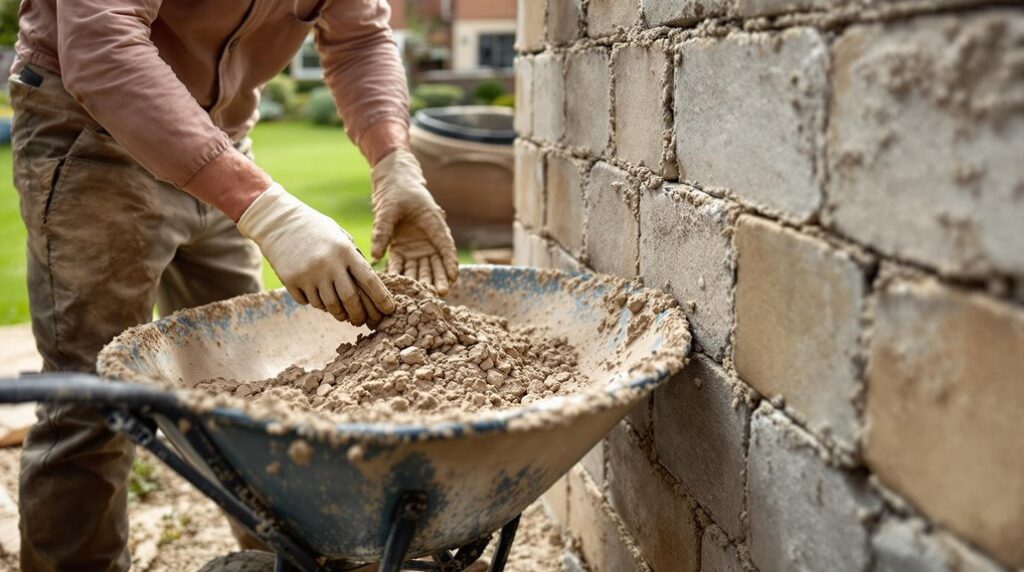When I’m working with concrete blocks in the UK, I’ve learned that choosing the wrong mortar mix can compromise your entire wall’s structural integrity. You’ll need to understand the specific requirements for different load-bearing applications, from lightweight partition walls to heavy-duty foundation work. The difference between a Type M and Type N mix isn’t just technical jargon—it’s what determines whether your wall can handle the environmental stresses and loading demands it’ll face over decades of service.
Key Takeaways
- Use Type M mortar (1:0.25:3.75) for high-load applications, delivering 1800-2500 psi compressive strength for structural walls.
- Select mortar class iv/M2 for lightweight blocks and iii/M4 for dense blocks in internal walls above damp-proof course.
- External unrendered walls require class iii/M4 mortar for dense blocks to meet UK building standards and weather resistance.
- Match mortar strength to block compressive strength; use blocks ≥7.3N/mm² for high-load areas requiring structural performance.
- Comply with BS EN 1996-1-1 for masonry structures and use materials meeting British Standards for legal construction requirements.
Understanding Mortar Types and Strength Requirements for UK Concrete Block Construction

When you’re selecting mortar for concrete block construction in the UK, you’ll need to navigate two distinct classification systems that determine both strength and durability requirements. Under BS EN 998-1/2, you can choose between design mixes (strength-based) or prescribed mixes (recipe-based), though design mixes align better with Eurocode 6 standards.
For internal walls above dpc, I recommend mortar class iv/M2 for lightweight blocks or iii/M4-M2 for dense blocks. External unrendered walls require class iii/M4 mandatory for dense blocks. Your mortar strength must match your block’s compressive strength—if you’re using blocks ≥7.3N/mm² for high-load areas, make certain your mortar meets this threshold. Dense blocks at 1,900kg/m³ need high-strength mortar ranging 7.3–40N/mm² for peak structural performance.
Selecting the Right Mix Ratio Based on Your Project’s Load-Bearing Needs
Your mortar strength classification directly determines the mix ratios you’ll need for different structural applications. For high-load projects like retaining walls and foundations, I recommend Type M mortar at 1:0.25:3.75 (cement:lime:sand) delivering 1800-2500 psi compressive strength. You’ll need Type S mortar for below-grade work, using 1:0.5:4.5 ratios that handle soil pressure and moisture effectively.
Medium-load applications like exterior walls perform well with Type N mortar at 1:1:6 ratios, providing 750 psi strength without excessive rigidity. For non-load-bearing partitions, Type O mortar at 1:2:9 offers sufficient 350 psi strength while maintaining flexibility. Consider environmental factors like temperature and humidity when selecting your mortar type, as these conditions significantly impact performance and curing.
I’d avoid traditional UK 1:1:6 ratios for modern blockwork—they lack structural integrity. Instead, match your mortar type to your project’s specific load requirements for peak performance.
Essential Mixing Techniques and Best Practices for Professional Results

Once you’ve selected your mortar type and ratios, proper mixing technique becomes the difference between professional-grade results and structural failure. I’ll walk you through the essential methods that separate skilled builders from weekend warriors.
Start by thoroughly combining your dry ingredients—cement and sand at your chosen 3:1 or 4:1 ratio—before introducing any water. Create a crater in your dry mix’s center, then gradually add water to prevent lumps. I always premix plasticizers with water first; this guarantees even distribution and improves workability while reducing water requirements by 5-15%.
For projects exceeding 50kg, use mechanical mixers. They ensure uniformity and save considerable labor. Remember, proper consistency means your trowel ridges hold shape without collapsing—that’s your professional benchmark. Always clean your mixing equipment immediately after use to prevent cement from hardening and damaging your tools.
Common Mistakes That Weaken Concrete Block Walls and How to Avoid Them
Perfect mixing technique won’t save you from structural failure if you’re making critical errors during planning and construction. I’ve seen too many walls fail because builders skipped proper site assessment or ignored UK building regulations for wind resistance.
Your mortar’s only as strong as your weakest link. Don’t use blocks below 3.5N/mm² compressive strength, and always inspect for cracks before installation. Store blocks properly to prevent water absorption that’ll compromise your bond. Additionally, be aware that load-bearing walls are crucial to a building’s structural integrity and should be carefully assessed before making any alterations.
The biggest mistake I encounter? Omitting pad stones under steel beams, leading to catastrophic point-load failures. Never use “strong boys” instead of proper needles for structural support. Keep mortar joints under 10mm thickness, and don’t rush curing – protect from moisture for 72 hours minimum. Recent Building Regulations now require cavity widths of at least 125mm to meet current insulation standards.
UK Building Standards and Compliance Requirements for Mortar Mixes

While proper mixing technique forms the foundation of strong mortar, compliance with UK building standards determines whether your concrete block construction meets legal requirements and performs safely over time.
I’ll guide you through the essential standards that govern our mortar specifications. BS EN 1996-1-1 serves as your primary reference for masonry structures, mandating Class iii (M4) mortar for above-damp-proof-course applications. Your materials must meet specific British Standards: sand conforming to BS EN 13139, lime to BS EN 459-1, and cement to BS EN 197-1.
The regulations require using the weakest mortar mixture appropriate for structural demands—this prevents unsightly cracking while maintaining strength. For aerated blocks, you’ll need pre-mixed thin joint mortar creating 2mm joints. Always follow manufacturer instructions for admixtures, as non-compliance compromises durability and potentially violates building codes. Additionally, ensure all block surfaces are clean and dust-free before mortar application, as contaminated surfaces compromise adhesion and structural integrity.
Conclusion
I’ve covered the essential aspects of selecting and mixing mortar for concrete block construction in the UK. You’ll achieve strong, durable walls by choosing the right mortar type for your load requirements, following proper mixing techniques, and adhering to BS EN 998-1/2 standards. Don’t compromise on quality—use Type M mortar for high-load applications and guarantee you’re meeting UK building regulations. Your attention to these technical details will determine your wall’s long-term structural integrity.
References
- https://www.buildingmaterials.co.uk/info-hub/building-materials/mortar-mix-ratios
- https://www.beesleyandfildes.co.uk/mortar-mix-ratios-and-cement-mixing/
- https://media.marshalls.co.uk/image/upload/v1611238100/Mortars-For-Concrete-Masonry-Products-BTB4.pdf
- https://lignacite.co.uk/wp-content/uploads/2023/01/Design-Guidance-Mortar.pdf
- https://www.buildingconservation.com/articles/mortar-mix-ratios/mortar-mix-ratios.html
- https://www.mpaprecast.org/Precast/media/BPMediaLibrary/Publications/MMA_EasyGuide_Blocks.pdf
- https://www.tarmac.com/wp-content/plugins/tarmac.com/components/downloads/file-download.php?download_id=3901
- https://www.standardsforhighways.co.uk/tses/attachments/cf874a98-84ae-42b0-8269-0641aa59ceb8?inline=true
- https://www.diy.com/ideas–advice/building–hardware/cement-mortar–concrete/concrete-mix-ratios
- https://www.youtube.com/watch?v=JI7p9zop-kQ

